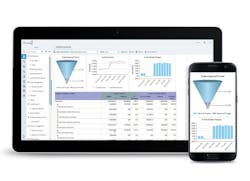The Future of Water and Wastewater Infrastructure Is Digital
Capital infrastructure is getting a total overhaul thanks to a $1.2 trillion plan recently passed by the federal government. This plan was a long time coming, as American infrastructure has been deteriorating for years due to neglect.
While our original water and wastewater structures have served constituents well for decades, the capital infrastructure industry has reached a critical moment. It is time for capital infrastructure programs to come into the digital age. Without this adjustment, American cities and the infrastructure that supports them will be unsustainable, requiring costly updates over time rather than lasting through the next several decades.
The construction of reliable water and wastewater infrastructure was an incredible achievement in the 20th century. Now, we must work to build a more sustainable future by revitalizing and digitizing existing infrastructure and building newer, better infrastructure that is reliable for the next generation.
Modern capital infrastructure plans have relied on outdated processes to move projects from planning to delivery. Federal and municipal projects have been held together with paper and tape, literally and figuratively, as multiple departments and stakeholders have tried to collaborate on large-scale projects while using analog methods.
Even where computers are used, most capital planning projects still rely on rudimentary spreadsheets that are not transferable or accessible across users. Unfortunately, in many cases, poor communication and execution have led to projects being delayed or going over budget, both of which introduce costs that fall on the taxpayer.
Many capital planning organizations still use paper plans and forms to determine the status of a project or to verify a stakeholder’s sign-off. These documents are shared between multiple teams, across multiple locations, and through different distribution channels, and this outdated method ultimately creates delivery delays. This will not hold up as the United States focuses more attention and funding on the country’s infrastructure. The $55 billion that has been dedicated for water and wastewater funding through the Infrastructure and Investment Jobs Act will set major plans into motion and create more projects for federal and municipal governments to sustain.
This is why capital infrastructure leaders must digitize their departments. Without the right tools on hand, water and wastewater program managers will be unable to sustain the necessary processes that ensure the smooth progression and delivery of a project.
Optimizing Water & Waste Management With Digital Tools
Tampa Bay Water is the largest wholesale drinking water supplier in the southeastern U.S. and, as such, needs to supply safe, clean water to 2.5 million residents. Its outdated, homegrown management solution caused confusion and disorganization and resulted in duplicated efforts. Tampa Bay Water’s simple, straightforward goal of providing reliable drinking water was made an inefficient, error-ridden process that negatively impacted how the organization functioned.
Tampa Bay Water employed the Aurigo Masterworks Cloud, a single-solution construction lifestyle management software, to overhaul its reporting system and digitize essential processes. Appropriately suited for a water and wastewater project of this magnitude, the software solution pulls data about simultaneous projects together to provide a single source of truth to govern large-scale capital planning initiatives.
Capital planners and infrastructure leaders have relied too long on multiple forms of documentation, outdated communication methods, and siloed workflows and team members to govern large-scale projects. These outdated methods of project management have adversely affected the infrastructure industry by significantly stalling progress on new construction, revitalization, and operation projects.
Operating with multiple sources of information (like paper documentation of project plans or approvals) creates discrepancies across departments that project managers must then rework to resolve. This rework time is costly, and when understood through the lens of government-funded projects like those supported by the new infrastructure bill, it costs American taxpayers an inordinate amount of money.
Tampa Bay Water leveraged construction lifecycle management software to pull all capital program data into one single source so that decision-makers could plan, build and operate projects from a single-platform perspective. Even further, an automated system streamlines the most tedious — but often most essential — tasks associated with capital projects, like estimations, reporting, and document management. Project stakeholders used the platform to speed up approval and delivery so that time, energy, and effort were not wasted.
Serving Taxpayers by Making Water & Wastewater Management Efficient
Large-scale water and wastewater infrastructure projects need to be efficient and cost-effective to win the support of taxpayers who fund them. These projects also directly impact the lives of taxpayers, who rely on cities to provide them with water and wastewater management services.
It is nearly impossible to provide the level of transparency that constituents desire in such projects when capital infrastructure programs are governed by outdated, paper-based methods (as they have been for years). Those documents are not easy to track, report, analyze, or distribute, and it makes it difficult for constituents (or representatives of constituents) to understand the status and impact of those projects. This can have a negative impact on the trust built between the agency and its constituents.
Digitization can and will make water and wastewater management a more transparent and accountable facet of American infrastructure. With the right digital tools in hand, stakeholders can leverage data insights to track project progress and then communicate those details with the community. When it comes to programs funded by a $55 billion dollar bill, this accountability is essential.
Transparency & Openness
In 2022, Aurigo Software rolled out a new software application that allows constituents to provide feedback during the capital planning process. It was designed for cities and municipalities to streamline public involvement. The system, Aurigo Engage, uses social media to connect constituents with project stakeholders. When taxpayers provide feedback about capital projects, this information is analyzed using AI to categorize, rank, and display comments so that stakeholders and constituents alike can understand where the project stands in the public eye.
It is essential that stakeholders have this information about public support early on in the capital planning process when it is the least expensive to make changes. The technology can replace time-consuming meetings, like town halls, and cumbersome analysis processes, like surveys. This transparency is essential, and it will ultimately increase the positive impact of capital projects because, thanks to AI-driven technology, decision-makers can analyze feedback quickly and adjust plans accordingly.
Digitizing the capital planning process has served multiple cities well and created more efficient and effective projects. For example, Oklahoma City recently selected Aurigo Masterworks Cloud to digitize its outdated water management system ahead of a considerable infrastructure project. Digitalization in capital planning is critical both for the success of infrastructure projects and the safety of constituents.
Conclusion
Constituents need clean drinking water and sanitation services in order to go about their daily lives, and it is the responsibility of capital planning agencies to ensure that the systems that support water and wastewater management function properly.
With a considerable amount of funding heading toward American infrastructure programs, it is time for state and municipal governments to prioritize digitization so that projects can be delivered on time and on budget. The IIJA is a monumental opportunity for public agencies to step into the digital age and connect with their communities using 21st-century technology.
About the author: Balaji Sreenivasan is the CEO and founder of Aurigo Software.

